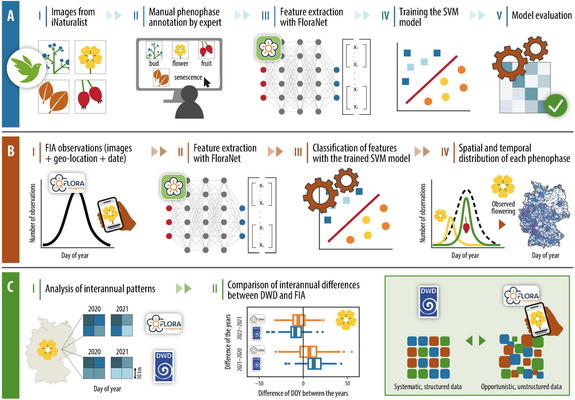@kuketzblog
- RethinkDNS
- #Warnwetter
- #FloraIncognita
- Firefox Klar
- Firefox
- K9Mail
- DLF (Deutschlandfunk)
- DLF-Nachrichten
- WDR
- Free42
#FloraIncognita
Wir freuen uns sehr, dass ein neues Paper unserer Forschungsgruppe nun veröffentlicht ist! Die begleitende #Wisskomm bereiten wir gerade vor, aber wer neugierig ist, kann gern schon mal reinlesen:
https://link.springer.com/article/10.1007/s00484-025-02972-x
In kurz: Wir haben eine sehr effiziente Methode entwickelt, Pflanzenbilder mit phänologischen Stadien zu annotieren, damit diese für neue Forschungsfragen noch mehr Informationen bereit halten.

Das ist der Rauhaarige Alant (Pentanema hirtum). Gefunden im Naturpark Kyffhäuser. Hast Du ihn schon mal gesehen?
#Fotomontag in Symmetrie
So bin ich mit dem #Altglas und Makroring im verwilderten Teil des Gartens mal wieder überrascht worden, was es dort zu sehen gibt. #Floraincognita sagt, es handelt sich um den gewöhnlichen #Mauerlattich. Durchaus sehenswert, oder?!
Nach ihr wurden geologische Zeitabschnitte (Drei Kaltzeiten im Pleistozän) benannt - Dryas octopetala, die Weiße Silberwurz. Sie ist ein Glazialrelikt der europäischen Hochgebirge.
Wow. So viele Knäuel-Glockenblumen (Campanula glomerata) sieht man selten auf einem Punkt. Regional gibt es verschiedene Unterarten, und auch weiße Exemplare kommen vor. Laut #RoteListeZentrum ist ihr aktueller Bestand in Deutschland „mäßig häufig“, allerdings mit einem Trend zum starken Rückgang in den Wildbeständen.
Sonntagsspaziergang
Blumen gesucht - blühende Kletten gefunden
#silentsunday #bloomscrolling #floraIncognita
Da Ihr das kleine unscheinbare Moosauge wahrgenommen habt, habt Ihr Euch nun etwas flashy verdient: Cirsium heterophyllum, die Verschiedenblättrige Kratzdistel, mit Zitronenfalter (Gonepteryx rhamni). Schön, nicht wahr?
Die kleinen zarten Schwebfliegen ich freue mich über ihre Schwebtänze. Mein Garten ist mit 100qm eine Insektenoase. Ich hatte mich bereit erklärt am #floraincognita #gartendivers Forschungsprojekt teilzunehmen. Bislang komme ich auf gut 100 Arten. Darunter viele Pflanzen, die nicht aus der Gärtnerei, sondern mit meiner Hilfe aus der Natur eingewandert sind. Besonders diese sind von den kleinen Insekten besucht. #garten #schwebfliegen #insekten #artenschutz #klimawandel
„Lebendgebährende“ Gräser
Naja nicht ganz
Poa alpina, das Alpen-Rispengras, betreibt unechte oder falsche Viviparie, auch Pseudoviviparie genannt. Schon innerhalb des Blütenstands bildet es manchmal neue Pflänzchen aus.
Cool oder?
#Alpenexkursion #FloraIncognita #Pflanzenwissen
@FloraIncognita_DE @OhWeh
Und es gibt noch einen Unterschied zu den Laber-Laber-Maschinen: #FloraIncognita sagt dir einfach die erkannte Pflanzenart und wie sicher das Ergebnis vermutlich ist. Kein überflüssiges Geschwätz, keine leeren Versprechungen.
Eine KI kann nur so gut sein wie ihre Datengrundlage. Deswegen legen wir sehr viel Wert darauf, dass die stimmt. Mit klassischen Werkzeugen.
In den Blattachseln der Wilden Karde (Dipsacus sylvestris) sammelt sich Regenwasser. So entstehen Phytotelmata (Einzahl: #Phytotelma), die einer Vielzahl von Organismen Lebensraum bieten - und damit zusätzlich die Pflanze mit beispielsweise Stickstoff versorgen können. Wusstest du das?
Wilde Natur vor der Haustür. Der Gewöhnliche Natternkopf (Echium vulgare) hat das Buffet für den Argus-Bläuling (Plebejus argus) eröffnet.
Das Sommer-Adonisröschen (Adonis aestivalis) wird umgangssprachlich auch Blutauge, Blutströpfchen, Sommerblutströpfchen, Feuerröschen oder Kleines Teufelsauge genannt. Wie nennst Du es?
#wildblume #wildflowers #natur #feldrand #wildkräuter #pflanzenbestimmen #orangeflowers #floraincognita
@calvato Ich mag deinen #balkonurwald sehr und die Bilder davon.
Meiner ist nicht ganz so dicht aber immerhin habe ich mit #floraincognita auch über 20 Pflanzenarten gefunden, knapp die Hälfte davon hat sich alleine bei mir eingefunden.
Das Echte Mädesüß (Filipendula ulmaria) öffnet seine Blüten.
@berndchen Ach. Genau die hatte ich auch verwechselt. #FloraIncognita klärte mich dann auf.
Lilium martagon, der Türkenbund (oder die Türkenbund-Lilie) ist eine der größten einheimischen Lilien-Arten. Die Exemplare im Bild wachsen in einem schattigen Wald und erreichten „nur“ 60cm Höhe. An hellen, warmen Standorten ist mehr als das Doppelte ist möglich. Leider knuspern Rehe zu gern die Blütenknospen ab, sodass bei „unserem“ Massenvorkommen bei Jena nur sehr wenige Exemplare überhaupt zur Blüte kommen.
